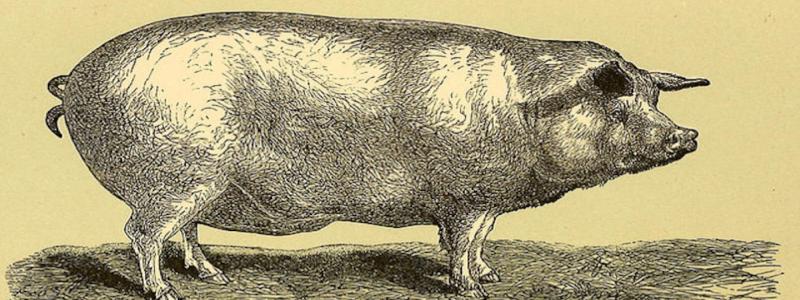 If you are fond of obscure and slightly absurd history, the Pig War of 1859 is the war for you. It involved a territorial dispute between the United States and Great Britain over the San Juan Islands of the Pacific Northwest. On the American side, 461 soldiers armed with 14 cannons on San Juan Island faced over 2,140 British sailors, soldiers and marines on five British warships mounting 70 guns. Famous or soon-to-be-famous army officers, naval captains, an admiral, and even the German Emperor would play a role in the conflict which lasted over 12 years. When it was all finally over, the only casualty was a pig.
If you are fond of obscure and slightly absurd history, the Pig War of 1859 is the war for you. It involved a territorial dispute between the United States and Great Britain over the San Juan Islands of the Pacific Northwest. On the American side, 461 soldiers armed with 14 cannons on San Juan Island faced over 2,140 British sailors, soldiers and marines on five British warships mounting 70 guns. Famous or soon-to-be-famous army officers, naval captains, an admiral, and even the German Emperor would play a role in the conflict which lasted over 12 years. When it was all finally over, the only casualty was a pig.
A treaty signed in 1818 between Great Britain and the United States provided for the joint occupation of the “Oregon Country,” a loosely defined region that included what is now Oregon, Washington State, and much of British Columbia.
The Oregon Treaty of 1846 sought to define more precisely which nation owned which territory. It established that the United States owned the Pacific Northwest below the 49th parallel west of the Rocky Mountains, extending “to the middle of the channel which separates the continent from Vancouver’s Island; and thence southerly through the middle of the said channel, and of Fuca’s straits to the Pacific Ocean.”
The problem was that the “channel which separates the continent from Vancouver’s Island” has three islands forming their own channels. The largest of the three, San Juan Island, was claimed by both the British and the Americans. Britain’s Hudson’s Bay Company established a sheep ranch on San Juan while, by mid-1859, twenty-five to twenty-nine American settlers had arrived to start farming the island.
on June 15, 1859, when an American settler named Lyman Cutlar shot and killed a pig belonging to the Hudson’s Bay Company because it was rooting in his garden. When British authorities threatened to arrest Cutlar, American citizens drew up a petition requesting U.S. military protection. Brigadier General William S. Harney, the anti-British commander of the Department of Oregon, responded by sending a company of the 9th U.S. Infantry under Captain George E. Pickett (of later Civil War fame) to San Juan. Pickett’s 66-man unit landed on July 27 and occupied a commanding spot near the Hudson’s Bay Company wharf, just north of the sheep ranch.
James Douglas, governor of the new Crown Colony of British Columbia, was angered at the presence of American soldiers on San Juan. He had three British warships under Captain Geoffrey Hornby sent to dislodge Pickett but with instructions to avoid an armed clash if possible. Pickett, though overwhelmingly outnumbered, refused to withdraw. In the meantime, Pickett received reinforcements bringing his troop total to a still significantly outnumbered 471 soldiers.
Throughout the remaining days of July and well into August, the British force in Griffin Bay (then San Juan Harbor) continued to grow. Captain Hornby, however, wisely refused to take any action against the Americans until the arrival of Rear Admiral Robert L. Baynes, commander of British naval forces in the Pacific. Baynes, appalled at the situation, advised Douglas that he would not “involve two great nations in a war over a squabble about a pig.”
The United States government was also unhappy about the prospect of war with Britain over a farm animal. General Winfield Scott was dispatched to negotiate a truce. Both sides agreed to a scaled-back joint military occupation of the island pending a resolution of the boundary dispute.
The Americans, however, became very distracted by the Civil War which threatened to rip the country in two. Finally, in 1871, Great Britain and the United States referred the San Juan question to Kaiser Wilhelm I of Germany for settlement. The kaiser referred the issue to a three-man arbitration commission who met for nearly a year in Geneva.
On October 21, 1872, the commission, through the kaiser, ruled in favor of the United States, establishing the boundary line through Haro Strait. Thus the San Juan Islands became American possessions and the final boundary between Canada and the United States was set. On November 25, 1872, the Royal Marines withdrew. By July 1874, the last of the U.S. troops had left the island. Peace had finally come to the 49th parallel, and San Juan Island would be long remembered for the “war” in which the only casualty was a pig.
Pig War “Standoff at Griffin Bay” from Raena Parsons on Vimeo.
Thanks to Karen Lorentz for contributing to this post.

Ya, don’t know, but I stopped eating all pork products about 2 or 3 years ago. No, I’m not Muslin or a Jew.
I thought that: it’s causing my psoriasis.
And: It’s to close to human meat.
My Psoriasis has mostly cleared up.
What’s odd is, people don’t know that ribs and ham comes from a froms pigs.
Having biked around the San Juans in my youth, the small shops make a living off that pig…
I am surprised no one offerred to replace the pig as a way to end the conflict.
OH!
I almost forgot about “The Brass Monkey”!
Very important!